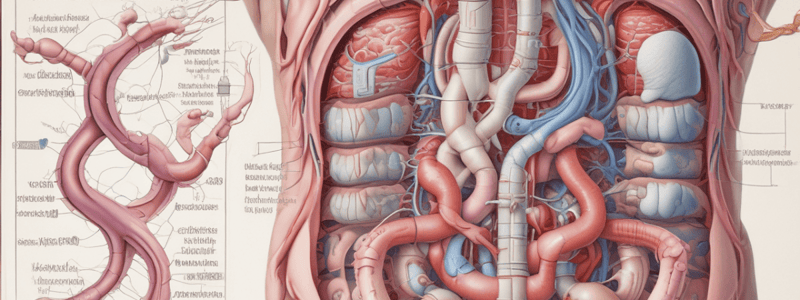Podcast
Questions and Answers
What enzyme found in saliva is responsible for breaking down large polysaccharides into smaller ones?
What enzyme found in saliva is responsible for breaking down large polysaccharides into smaller ones?
- Lipase
- Amylase (correct)
- Sucrase
- Protease
When Timmy chews the butterfly, what is the primary purpose of this action in terms of digestion?
When Timmy chews the butterfly, what is the primary purpose of this action in terms of digestion?
- To directly absorb nutrients from the butterfly
- To mix the saliva with the butterfly
- To prevent the butterfly from escaping
- To increase the surface area for enzyme action (correct)
Where does the chewed-up and saliva-soaked food go after the tongue forms it into a ball?
Where does the chewed-up and saliva-soaked food go after the tongue forms it into a ball?
- Esophagus
- Pharynx (correct)
- Small intestine
- Stomach
Which part of the gastrointestinal tract is responsible for the junction of the mouth and nasal airways?
Which part of the gastrointestinal tract is responsible for the junction of the mouth and nasal airways?
Besides breaking down polysaccharides, what other function does amylase perform during digestion?
Besides breaking down polysaccharides, what other function does amylase perform during digestion?
What happens when Timmy swallows?
What happens when Timmy swallows?
What is the function of pepsinogen in the stomach?
What is the function of pepsinogen in the stomach?
How does the stomach protect its epithelial cells from being digested by pepsin and hydrochloric acid?
How does the stomach protect its epithelial cells from being digested by pepsin and hydrochloric acid?
What causes the stomach to 'growl' when it's close to mealtime?
What causes the stomach to 'growl' when it's close to mealtime?
Why are most digestive enzymes produced in an inactive form called zymogens?
Why are most digestive enzymes produced in an inactive form called zymogens?
Study Notes
The Digestive Process
- Begins with amylase in saliva breaking down food into smaller polysaccharides
- Chewing physically breaks down food into smaller pieces, increasing surface area for enzymes to contact
The Mouth
- Salivary glands release saliva containing amylase to break down complex carbohydrates
- Amylase breaks down polysaccharides into smaller ones, breaking every other bond between sugars
The Throat
- The tongue forms chewed food into a ball and directs it to the pharynx
- Food enters the esophagus, which pushes it down into the stomach through muscle contractions
The Stomach
- A large, elastic organ that can stretch to hold over a half-gallon of food and fluid
- Lined with epithelial cells that secrete gastric juice
- Gastric juice liquefies food and continues the process of chemically breaking it down
Gastric Juice
- Contains hydrochloric acid (HCl), a strong acid that kills most bacteria in food and dissolves tissues
- HCl inactivates amylase, leaving polysaccharides partially digested
- Contains pepsin, a digestive enzyme that breaks proteins into smaller peptides
Pepsin and Pepsinogen
- Pepsin is produced in an inactive form called pepsinogen to prevent it from damaging cellular proteins
- HCl in gastric juice removes extra amino acids from pepsinogen, converting it into active pepsin
- Most digestive enzymes are produced in an inactive form (zymogen) to prevent self-digestion
Stomach Protection
- Epithelial cells secrete mucus to protect themselves from acid and pepsin
- The stomach is empty and inactive between meals, but prepares for a meal when food is anticipated
- The brain sends a signal to the stomach to start preparing for a meal, causing epithelial cells to secrete HCl and smooth muscles to churn at a low rate
Studying That Suits You
Use AI to generate personalized quizzes and flashcards to suit your learning preferences.
Description
Explore the anatomy and functions of the upper gastrointestinal tract, from the mouth to the stomach. Learn about the digestive process and how different organs work together to break down food for absorption.


